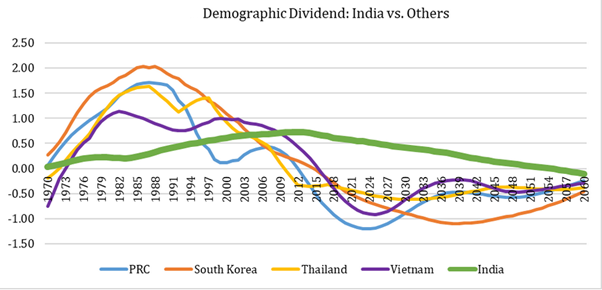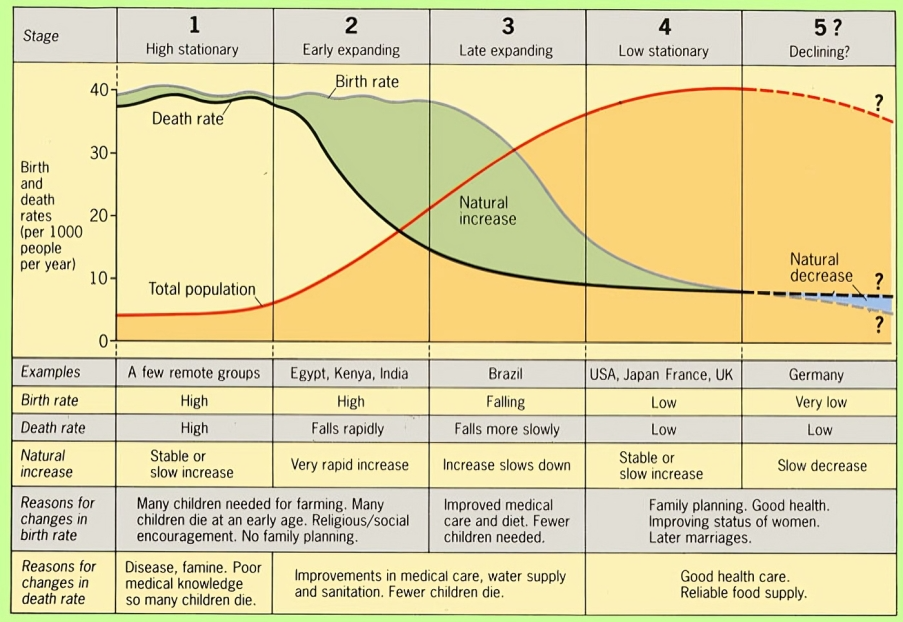Indian Society
Demographic Transition of India
- 13 Apr 2024
- 10 min read
For Prelims: Demographic Dividend, Total Fertility Rate (TFR), Mahatma Gandhi National Rural Employment Guarantee (MGNREGA), Asia 2050 report.
For Mains: Demographic Transition In India, Significance of India’s Demographic Dividend, Challenges Associated with India’s Demographic Dividend.
Why in News?
India's population growth has been a major focus, with projections of reaching 1.7 billion by 2065, according to the UN Population Division, underscoring the ongoing Transition of Demographic Dividend in India.
- It shifts the focus to a crucial but lesser-discussed aspect, declining fertility rates, which according to the Lancet Report is projected to go down to 1.29 by 2051.
- The government's projected Total Fertility Rate (TFR) for the period 2021-2025 (1.94) and 2031-2035 (1.73) is higher than estimates from The Lancet study and NFHS 5 data.
- This suggests that India's population may stabilise below 1.7 billion earlier than 2065.
What is the Demographic Transition and Demographic Dividend?
- A demographic shift refers to a change in the composition of a population over time.
- This change can occur due to various factors such as changes in birth and death rates, migration patterns, and changes in social and economic conditions.
- A demographic dividend is a phenomenon that occurs when a country's population structure shifts from having a high proportion of dependents (children and elderly) to having a higher proportion of working-age adults.
- This change in population structure can result in economic growth and development if the country invests in its human capital and creates conditions for productive employment.
What Factors Triggered Demographic Transition in India?
- Rapid Economic Development:
- The pace of economic development, particularly since the early years of the 21st century, has been a significant driver of demographic transition.
- Economic growth leads to improved living standards, better healthcare facilities, and increased access to education, which collectively contribute to lower fertility rates.
- Reduction in Infant and Child Mortality Rates:
- Lower mortality rates among infants and children have reduced the need for families to have a large number of children for old-age support.
- As healthcare facilities improve and child mortality decreases, families feel more confident in having fewer children.
- Rise in Women's Education and Work Participation Rates:
- Increased education and participation of women in the workforce have also played a crucial role.
- As women become more educated and financially independent, they tend to have fewer children and delay childbirth, leading to a decline in total fertility rates.
- Improvement in Housing Conditions:
- Better housing conditions and access to basic amenities contribute to improved quality of life, which, in turn, affects family planning decisions.
- Families may opt for smaller family sizes when they have better living conditions.
What are the Challenges of Demographic Transition in India?
- Dependency Ratio Shift:
- While initially, the decline in TFR leads to a fall in the dependency ratio and a larger working-age population, it eventually results in a larger share of elderly dependents.
- This places a strain on resources for healthcare and social welfare, similar to the situations observed in China, Japan, and European countries.
- Uneven Transition Across States:
- The decline in fertility rates is not uniform across all states in India. Some states, particularly larger ones like Uttar Pradesh, Bihar, and Jharkhand, may take longer to achieve replacement level fertility.
- This can exacerbate regional disparities in economic development and healthcare access.
- Labour Productivity and Economic Growth:
- While the demographic transition can potentially increase labour productivity and spur economic growth, it also poses challenges in terms of managing the aging workforce and ensuring adequate skills development for the younger population.
What are the Opportunities of Demographic Transition in India?
- Enhanced labour Productivity:
- The demographic transition can lead to a deceleration in population growth.
- This can result in a higher availability of capital resources and infrastructure on a per capita basis, ultimately boosting labour productivity.
- Reallocation of Resources:
- Decreasing fertility rates enable the reallocation of resources towards education and skill development, which can lead to improved human capital and workforce productivity.
- A declining TFR will lead to a situation where the number of children enrolling in schools is lower, as is already happening in states like Kerala.
- This could improve educational outcomes without additional resources being spent by the state.
- Decreasing fertility rates enable the reallocation of resources towards education and skill development, which can lead to improved human capital and workforce productivity.
- Increased Women Participation in Workforce:
- A major factor responsible for the low participation of women in the workforce is their engagement in childcare at an age when they should be in the labour force.
- With less time needed for childcare, one would expect more women to join the labour force in the coming decades.
- The larger share of women in employment schemes like Mahatma Gandhi National Rural Employment Guarantee (MGNREGA) indicates a trend towards greater female labour force participation.
- Spatial Redistribution of labour:
- Movement of labour from regions with surplus labour to regions with growing industries can create spatial balance in the labour market.
- This would get an impetus with the modern sectors in the southern states, and Gujarat and Maharashtra, soliciting cheaper labour from the northern states.
- This, over the years, must result in improved working conditions, elimination of wage discrimination for migrant workers and the mitigation of security concerns in the receiving states through institutional safeguards.
Way Forward
- As mentioned in the Asia 2050 report, if India capitalises on these opportunities by focusing on sectoral and spatial redistribution of the workforce, skill development, and increasing women's participation in the workforce, it can emerge as a major economic player in the 21st century.
- India's demographic dividend, if harnessed effectively, can contribute significantly to global economic competitiveness.
- The evolving population dynamics have serious implications for policy formulation, particularly regarding healthcare, education, and skill development.
- There is a need for policies that address the specific needs of women and other marginalised groups, ensuring inclusive growth and development.
|
Drishti Mains Question: Q. Discuss the significance of India's demographic transition in the context of its potential economic growth and global competitiveness. Highlight the opportunities presented by declining fertility rates, increased women's participation in the workforce, and spatial redistribution of labour. |
UPSC Civil Services Examination, Previous Year Questions (PYQs)
Prelims:
Q1. In the context of any country, which one of the following would be considered as part of its social capital? (2019)
(a) The proportion of literates in the population
(b) The stock of its buildings, other infrastructure and machines
(c) The size of population in the working age group
(d) The level of mutual trust and harmony in the society
Ans: (d)
Q2. India is regarded as a country with “Demographic Dividend”. This is due to (2011)
(a) Its high population in the age group below 15 years
(b) Its high population in the age group of 15-64 year
(c) Its high population in the age group above 65 years
(d) Its high total population
Ans: (b)
Mains:
Q1. Discuss the main objectives of Population Education and point out the measures to achieve them in India in detail. (2021)
Q2. ‘’Empowering women is the key to control the population growth.’’ Discuss. (2019)
Q3. Critically examine whether growing population is the cause of poverty or poverty is the main cause of population increase in India. (2015)








